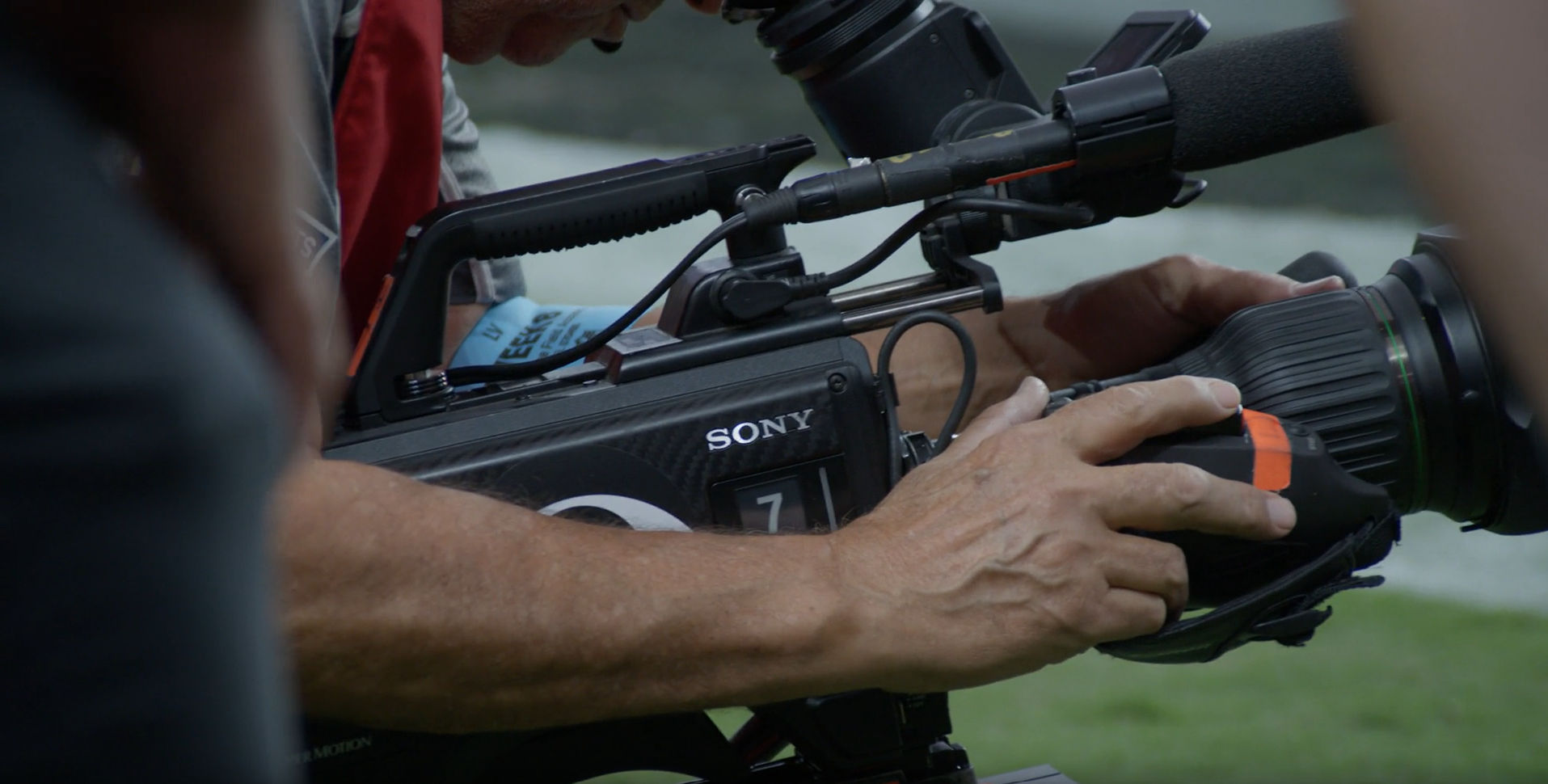Cameras: Bigger Sensors Bring a Bigger Cinematic Experience
Broadcasters cautiously embrace big-chip cameras

The subtle art of aiming cameras at live events is perhaps the part of film and television practice which has been most resistant to new technologies. While sheer specifications have skyrocketed, outside broadcast camerawork is marked by nothing more than a determination to maintain a consistent operator experience.
Recently, though, the drive for sheer gloss—driven, perhaps, by the ascendancy of single-camera drama from OTT distributors—has imposed change on this most change-resistant of fields.
Adapting to Live
Guilhem Krier, based in France, is Panasonic Connect’s Head of New Business & Market Development, and traces the origins of the trend to “concerts, mostly, where you want to have a very nice cinematic feel for the singer, and the background is blurry so the person is detached. I think it was 10 years ago.”
Larger-sensored options, Krier recalls, already existed, “but they were mostly designed for production work, with a full camera crew. There was a clear request for this kind of picture, but there was no product really designed in this way—a real studio camera, a broadcast camera with a cinematographic look to it. This is where the idea of products like the PLV100 came from.”
The AK-PLV100GSJ is Panasonic’s answer to the problem, a system camera with Super 35mm sensor announced in October 2022. Big chips, though, were already popular in adjacent fields, according to Krier.
“It’s not only broadcast sports,” Krier says, “but also integration. Corporate things, meeting rooms, theatres where we’re selling tons of PTZ cameras. The tendency is to go for bigger and bigger sensors, to get more sensitivity and also to get this kind of picture with a short depth of field.”
While the technological direction was straightforward, Krier describes the early big-chip broadcast experience, which often repurposed cinema cameras, as “an absolute nightmare in terms of blurry pictures and [poor] workflows.
The professional video industry's #1 source for news, trends and product and tech information. Sign up below.
“At the time I was mostly focused on the French market but we had big organizations like [industrial training organization] INA, and they had started tons of training and courses on how to manage focus not only with HD but with 4k and large sensors,” he said.
Time has allowed technique to mostly catch up with technology, Krier added.
“Today we don’t really have people coming up saying it’s too difficult to keep the pictures sharp, but for a long time it was a big topic, especially for people switching to full frame. Super 35 is a bit in the middle, but still you have super sharp sensors with 20, 30, 40 million pixels. It’s still a challenge.”
Super Sensor at the Super Bowl
Masakazu Murata is Senior General Manager, Head of Media Solutions Business Unit at Sony, and relates a somewhat comparable trajectory. “Particularly in sports broadcasting, where there’s a growing demand for cinematic visual expression, we're seeing cinema cameras like the Venice 2 being used more frequently. At this year's Super Bowl in February, in addition to a lot of Sony system cameras, Venice 2 and FX series cameras were also used.”
You need cameras with a global shutter because… high end sport productions often need to shoot LED walls with a virtual ad replacement system."
Klaus Weber, Grass Valley
Perhaps mindful of the ergonomic concerns associated with repurposing cinema cameras for live work, Sony announced its own Super 35mm system camera, the HDC-F5500V, at NAB this year. The new design, Murata confirms, “features a Super 35mm CMOS image sensor delivering impressive bokeh effects while maintaining system camera operability.
“There’s talkback and remote control, and a variable ND filter,” he added. “We've received very positive feedback from broadcasting professionals who appreciate the expanded range of visual expression options. They can mix traditional system cameras, with deep depth of field, and cinema cameras, with shallow depth of field, and select the appropriate visual style for each scene.”
Grass Valley’s Klaus Weber recognizes that mix-and-match option as key. Responsible for product management of camera solutions and technology, Weber reinforcinges the need for proper workflow integration of large-sensor cameras. “Yes, you can adapt UCPs to a camera and yes, you can add a tally light and yes, you can attach an intercom solution. But then it’s building a camera with external blocks to act like a live camera.”
Even then, Weber goes on, many cinema cameras remain compromised. “The time between light hitting the imager and the image being ready for distribution is one frame, perhaps,” Weber said. “It needs to be instant. And the camera does not have multiple live outputs—in live you need a UHD HDR signal but [also] a 1080p feed for shading or iso feeds. You need cameras with a global shutter because… high end sport productions often need to shoot LED walls with a virtual ad replacement system. Sometimes you can set it up so it works, but in a live environment, where you have to react to situations it simply doesn’t work.”
Grass Valley’s response is the LDX 180, launched at this year’s NAB. Weber describes the camera as expanding on a much-loved existing product.
“It’s taking one of our LDX 100 camera bodies and replacing the three-chip block with a newly-developed Super 35 optical block,” Weber said. “Since both imagers are developed with the same technology, the same development team even, they provide the same characteristics, global shutter and dynamic range. Because the imager is more than six times larger, we have more than six times more pixels which gives you a heavily oversampled image.”
Not For Everyone
Even so, Krier suggests that even the smoothest pictures are unlikely to persuade the industry to universal adoption (and the industry seems to concur).
“A big soccer match for the Champions League in Europe is typically 20, 30 cameras; the soccer field is more than a hundred meters long, so a camera high up, shooting down to a player on the ground, has a distance of at least 100 meters to the subject,” Krier said. “You need a focal length of 400-500mm and your depth of field is already close to zero.”
Crucially, the practical performance envelope of larger-sensor cameras is increasingly constrained by optics more than electronics. Joshua Stoner is Senior Technical Specialist at Canon, with responsibility for lenses, and describes the convergence of cinema and broadcast simply. “As the two industries have been on a collision course, they’ve had some crossover,” Stoner said. “Some of our cinema lenses and cameras have been getting broadcast-style operability, the ability to use a third-party control panel to shade our cameras.”
As regards broadcast-specific lens designs, though, Stoner is clear that Canon has no intention of following in the footsteps of Fujifilm and its upscale 25-1000mm PL-mount box zoom.
“I don’t think the market is enough to support the R&D,” Stoner said. “We looked into it when Fujifilm released theirs and went a different way—the cine-servo line of lenses. We have also started releasing the USM Z line, which are RF mount and have external zoom and focus controls. There’s an add-on module that gives you handheld zoom. It has a 20-pin connector, and with a Y-connector you can put on rear controls.”
This sort of hybrid lens technology, with the option to involve electronics in what was once an almost purely opto-mechanical device, seems like the most promising avenue for fundamental advancement in what can be done. “It’s a more video-focused lens,” Stoner says, “but it’s still an RF-mount photo lens, and it has that performance benefit [of a short flange focus distance]. It’s our advancement into that lower cost video kind of lens that people are screaming for.”
Stoner reports one other popular option among people looking for a broadcast operating experience, albeit one which may not extract the best performance from camera or lens: “to put a B4 lens on a cinema camera. That’s popping up more and more. Not very much in live, but a team might have a features group that shoots interviews or team footage and they’re trying to leverage the new cameras.”
Box-lens enthusiasts seem more likely to be entranced by an upgrade option for Canon’s Digisuper 122 and 111 lenses which occupies a previously-disused aperture on the extender.
“You can install this new optical block into the Digisuper 122 and 111 which helps mimic the shallow depth of field look—but you get the broadcast operability,” Stoner says. “And you’re not giving up a camera position. It’s not a true shallow depth of field, [but] the operators are operating the lens like they normally would, they’re not chasing focus and it gives the director the hero shot they want.”
That hybrid try for a best-of-both-worlds solution was announced at NAB 2025 and, Stoner says, was well-received. “The demand for it in the U.S. has been through the roof,” he said. “We’re ready to deploy this this summer in time for the NFL season.” Overall, it seems plausible that the desire for a large-sensor look might well take a third route of this kind, ideally skirting the practicality shortfalls of Super 35mm sensors.
Either way, Stoner concludes by echoing what seems to be the prevailing view. “I don’t see Super 35 overtaking ⅔-inch any time soon. I see it as an add-on inside the industry.”



